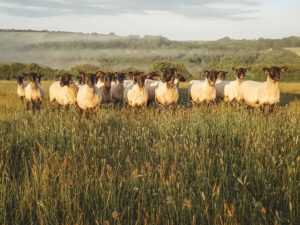- 8th July 2022
- Posted by: Steve Lewis
- Category: Pembrokeshire Lamb
Grass is free, right???
Like everyone else we too have been affected by the rising costs of living. One comment I have seen cropping up on social media when people are talking about the pricing of lamb is “But grass is free…”
Looking from the other side of the hedge I can see where this assumption comes from, however it is a lot more complex than that.
Grass is free, right?
No it isn’t, the land must be purchased (land prices are at an all-time high), or in our case we rent our farm. Even if you inherit the land there are still many costs to managing that land.
But, grass is free, right?
Well, there is grass and grass. So, again, no. We try to farm sympathetically with the environment, but this can be more costly as it is labour intensive. We are working towards implementing ‘mixed herbal leys’ – a mix of grass, herbs and other species which benefit not only biodiversity, but also the animals and soil too. Work needs to be done to get there. Invasive weeds such as nettles and docks soon colonise the fields if allowed (we do have managed patches of these, so they are not totally removed), and sheep will not eat them. Regenerating these fields takes time and a low stocking density too so as not to overgraze.
Fertiliser, no matter which method is used comes at a price. Artificial fertiliser costs have soared in the past year. Our supply of sheep manure accrued over lambing is a ‘free entity’, but there are still costs surrounding it. Without a tractor, trailer, muck spreader etc then we cannot use this. Be it rent or buy there are still costs, all of which require ever-more expensive fuel. On the plus side, manure is also great for building soil structure.
Many farmers have been spreading these extra costs by having more sheep, but over the long term this isn’t sustainable as the land is then put under increased pressure and can deplete quickly. To farm sustainably, we need to be able to carry less stock and care for the soil too. Land needs to be rested, mixed herbal leys including clovers help improve the soil structure and also fix/remove nitrogen from the atmosphere.
The sheep themselves have high care requirements. Not all sheep thrive off grass, and different sheep suit different farm systems. Selecting the ones suited to your farm takes time and a good eye. Breeding from genetically strong animals is paramount, not only for health but also for welfare. We select animals with good foot structure as they are less likely to suffer from problems associated with lameness, which can be unpleasant. This does keep our flock numbers low in the short term but looking to the future we hope the flock will be stronger, healthier and require less intervention.
Farmers and producers are constantly being pressured to produce food at lower cost, but when their baseline costs are increasing then how is this achievable without someone or something losing out? Everyone deserves a fair income.
When we began Pembrokeshire Lamb, market costs for live animals were low, not sustainable. This has since rectified itself and is now at a price where costs can be met for the farmers. We have kept our meat boxes price constant as it was calculated to be sustainable for all involved. We can pay our local butcher to cut the meat and hang it for longer, we chose her because of the care she gives the meat. We can use sustainable packaging, and reliable couriers, and make a small amount for ourselves too. There may come a time in the future when we have to revisit these costs, but it will not be taken lightly.
The biggest question I ask is “why is some food so cheap?” not “why is it so expensive?”. You’ve always got to ask, who is really paying the price to produce food so cheaply? 
